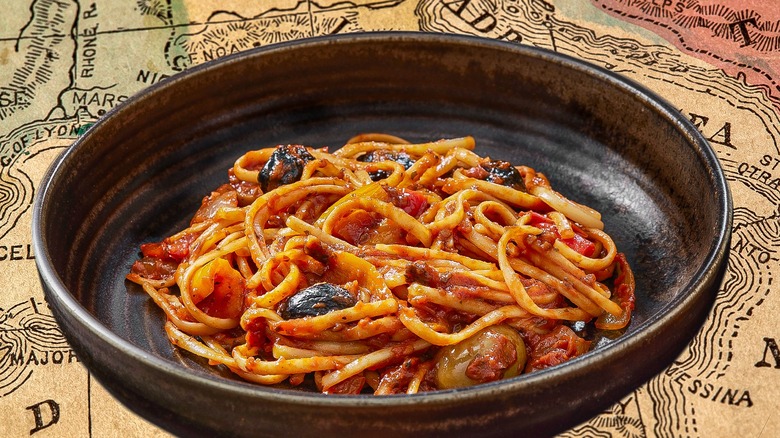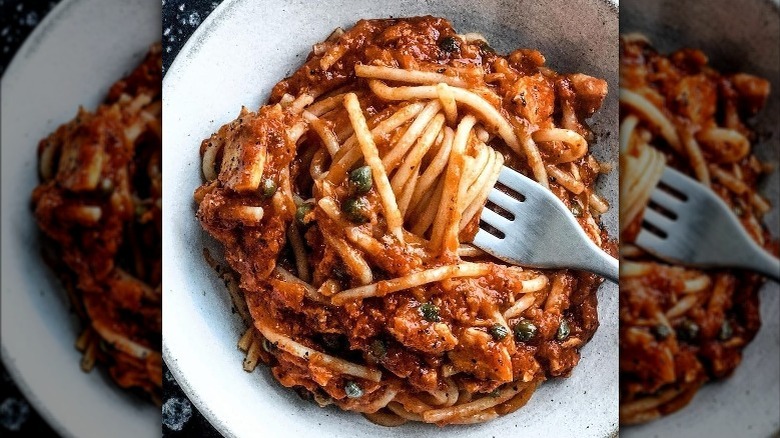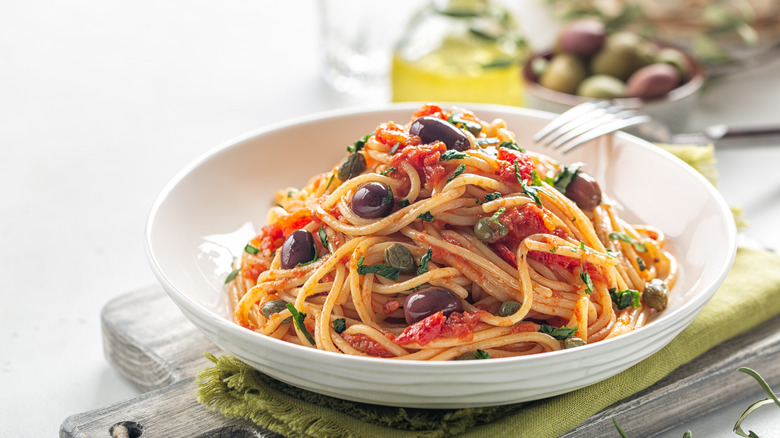The Unexpectedly Risqué Origins Of Puttanesca Sauce
If you have some knowledge of the Italian language or culinary history, you might know that puttanesca stems from the Italian word for "prostitute." But is this simply a coincidence, or does this pasta sauce have a sordid past?
Name aside, there's nothing risqué about the actual ingredients. The backbone of this sauce is crushed red tomatoes mixed with olives, capers, garlic, and herbs such as oregano and parsley. In some circles, chili flakes, anchovies, and basil are also the norm. This amalgamation results in a briny, umami flavor that adds a punch to any simple pasta. Not only does it bring that salty satisfaction to your plate, but it's prized for being a quick and easy dish.
So far, there's nothing fishy about this sauce besides the anchovies. So how did it become associated with such a controversial name? This remains a bit of a mystery since only a handful of sources document puttanesca's past. However, with the help of food historians and pasta aficionados, we've uncovered several origin theories. So let's dig into the spicy details behind this Italian pasta sauce.
A pre-history of puttanesca
At its core, puttanesca is a simple sauce. Its ingredients have been around for quite some time and are widely available in the Mediterranean. We may not have heard of pasta "alla puttanesca" until the second half of the 20th century, but chefs likely played around with the same ingredients long before.
In fact, there are records of similar sauces under different names. We came across an 1844 recipe in Cavalcanti's "Cucina Teorico – Practica" titled "Vermicelli all'oglio con olive capperi ed alici salse," which translates to "vermicelli with olive oil and an olive, caper, and anchovy sauce." In 1931, another similar recipe called "Maccheroni alla marinara" was published in the Touring Club Italiano's "Guida Gastronomica d'Italia."
However, the name "puttanesca" surfaced several decades later. Pasta "alla puttanesca" was popular in Italy circa the 1960s, and it first appeared in the New York Times in 1972.
The etymology of puttanesca
"Puttana" means prostitute in Italian so, loosely translated, puttanesca means "in the style of prostitutes." Historians have closely associated this meaning with the sauce's origin.
However, "puttanata" is used as a broad-spectrum profanity in Italy, describing something of little importance. For argument's sake, let's replace it with "stuff." When hungry, one might say, "Let's throw a bunch of stuff in the pan." Many culinary masterpieces are born this way, and as we'll soon discover, it provides another theory behind the origin of this Italian sauce.
But if we dig even deeper, you'll notice "puttana" bears a similarity to the Latin word "putida," meaning "stinky." Puttanesca sauce is known for its powerful aroma, especially when made with anchovies. Like any cooked fish, the smell is often unappealing until you identify it. When that switch goes off in your brain, your reaction changes from "eww" to "mmm" really fast. Knowing this, it's not far-fetched to assume someone smelled the dish and immediately gave it an unsavory name.
Whether the name comes from prostitutes, an improvised meal, or a stinky smell depends on who you talk to. Some reject claims of puttanesca's risqué origins, while others say it's the most plausible theory. Nothing is certain, and food historians are divided. Ultimately, it's up to you which story you prefer to believe.
Naples in the 1950s
The most widely-accepted theory of puttanesca is that it originated in Neopolitan brothels. It's said to have begun sometime in the mid-20th century in the Spanish Quarter of Naples, an area known at the time for its many "pleasure houses."
Whether it was a collective effort or a sole cook in the kitchen is up for debate. As one legend goes, a prostitute called Yvette the Frenchwoman created this sauce as a bit of an homage to her homeland, naming it after her own profession — perhaps in a humorous, self-deprecating way.
Others suggest that the colorful name refers to the flashy dresses worn by Naples' ladies of the night. Since puttanesca means "in the style of prostitutes," the colors of the dish could have resembled their attire. The red sauce, the purple olives, and the green capers paint a picture of the seductive garments these ladies may have worn.
An alluring aroma
In the mid-20th century, we imagine the streets of Naples being a wildly chaotic scene. As Jean-Paul Sartre recounts his experience here, "in putrefation, I love and I feel horror," and he refers to Naples as a "city that pours out every single element" (via Visit Naples). If you picture Naples' Spanish Quarter in the '50s, it would likely live up to this image. Known as the red light district, this is where people would go in search of prostitutes. But how would one identify a brothel among all the other illicit activities?
As rumors go, it was the Italian harlots who attracted men with the fragrant scent of puttanesca. We envision them cooking the sauce, opening windows to let the alluring aroma waft into alleyways. The smell of the rich tomato sauce would fill the corridors, luring potential clientele in the right direction. Despite the overwhelming sensory experience down these Neapolitan streets, puttanesca is powerful enough to stand out.
If we believe this theory, the Neopolitan sirens had quite the ingenuity. Not only could their culinary creation bring in business, but it would also provide a tasty meal for hungry workers and their clients.
A quickie that caught on
One of the biggest appeals of puttanesca is its prep time. On Reddit, one user explains, "It's fast. I am a slow cooker, and recipes that claim to take 30 minutes usually take me over an hour, but this actually takes me less than fifteen minutes to prepare. Then it's pretty much set and forget."
Italy prides itself on hospitality and cuisine — and we'd imagine this extends to all lines of work. As such, puttanesca seems like a natural addition to a busy bordello, providing sustenance to both working girls and their clientele. And word on the street is unfaithful wives also made this dish to cut down their cooking time. With evening hours to spare, they could escape the confines of 20th-century kitchens for romantic rendezvous. You might say they had their puttanesca and ate it too.
People love quick and easy meals that reward them with the gift of time. And puttanesca maintains these traits while still providing a rich umami flavor. As the best of both worlds, it's no wonder this quickie caught on — not only for busy "ladies of the night" but anyone looking to save themselves time.
A post-war pantry staple
Most historians believe pasta puttanesca was born in Naples circa the mid-1900s. But they often leave out one detail to support this claim: Naples was a war-torn city during this era. Resources of all kinds were limited, including access to running water and fresh food. As such, it's not surprising that pasta alla puttanesca became so popular. The sauce contains roughly seven ingredients, all of which are non-perishable.
Aside from food, locals also went to extreme measures to support themselves. Francesca Ruvolo, a graduate student of history at Rutgers University, explains how this developed in their dissertation. "As the city of Naples grew desperate, a thriving black market emerged within the city's broken walls...Because unemployment, misery, and starvation were pervasive in Naples, Italian women were forced to uphold the role of provider for their families." Women were responsible for juggling the duties of both cooking and working, and many turned to prostitution to make ends meet.
Allied troops entered Naples during this period, frequenting these houses of ill repute. If pasta puttanesca was served in these homes, the soldiers would likely have tried it during their stays. And upon returning to their homelands, they may have spread this simple recipe. After all, it's an easy ingredient list to both remember and obtain. Hence, it's not crazy to assume that pasta alla puttanesca made its way to other regions through the soldiers and Italian immigrants of the time.
A late-night culinary creation
A more wholesome theory has nothing to do with "ladies of the night" — but rather — the late-night munchies. In the 1950s, Sandro Petti owned the Rancio Fellone restaurant in the Ischia. He was ready to close up shop when a group of hungry friends sat down with a hankering for pasta. The customers had big appetites, but the chef had little in the kitchen. Despite his limited supplies, they pleaded with him, "Just make us a 'puttanata qualsiasi,'" referring to whatever "stuff" was lying around (per Do Bianchi). Petti did just as they asked. Rummaging through the cupboards, he mixed tomatoes, olives, and capers into a savory sauce, calling his final creation puttanesca — after "puttanata." His clientele was so pleased that he added it to his menu, and the rest was history.
We've all been there — you get a late-night craving but haven't gone shopping in ages. So, you create an easy dish from pantry staples. This quick thinking has been the birth of many new recipes. And while it isn't risqué, it's one of the most widely-accepted theories out there.
The puttanesca family tree
Sandra Petti's story is one the most well-known origin theories to date. However, there is another lesser-known hypothesis within the same family tree.
"La Cucina Napoletana," written by Jeanne Carola Francesconi, tells the story of Colucci, a Napoli-born painter who lived in Ischia. His Italian home had a rustic charm, with a terrace overlooking the sea. An olive tree grew right up through the middle, providing shade and creating the ideal setting to host his many dinner parties. At these quintessential Italian gatherings, Colucci invited fellow artists to feast on food and wine.
His signature dish, vermicelli alla puttanesca, was a creative adaptation of pasta alla marinara. How and why he decided to call it puttanesca is unknown. Perhaps, surrounded by artists, he gave it an avant-garde name — hinting at the suggestive neighborhood where he resided.
However, the plot thickens because Colucci was actually Sandra Petti's uncle. If we deem this story credible, it begs the question: Who influenced who? Is it possible they both possessed the creative genius to come up with the same dish at the same time? We may never know. But if we choose to believe it, the saying is true: The apple — or the olive, in this case — doesn't fall far from the tree.
Roman puttanesca
Just as language evolves over time, so does food. As dishes travel to faraway corners of the world, chefs adapt by using local ingredients and catering to their clientele's tastebuds.
This is precisely what happened in Rome. Naples is credited for the invention of this sauce, but the Romans created their own version — which may have surpassed the original. The primary difference in Roman puttanesca is the addition of anchovies. Many people already associate the dish with this salty fish, and most recipes you come across include them. Still, many people are surprised to learn that, traditionally speaking, the Neapolitan version doesn't contain any fish at all.
In Rome, it's also common to replace oregano with parsley and swap black olives for green ones. While Neapolitan puttanesca is usually served over vermicelli or linguine, Romans prefer to top it over penne pasta. The remaining ingredients are the same, and chefs from both regions will even happily put puttanesca sauce over spaghetti noodles.
Slattern's Spaghetti
Apparently, not everyone is a fan of this pasta's name. When chef Nigella Lawson published her own puttanesca recipe, she referred to it as Slattern's Spaghetti instead. It still contains all the essential ingredients, though, and the author doesn't deny that it is indeed a puttanesca sauce.
So why change the name at all? Lawson took to Twitter to explain her reasoning, "I feel that the word (puttanesca) has taken on a coarser, more cruel connotation, and I'm not happy with that." On her own blog, Nigella defends her chosen title, "Although you will often see its Italian name explained as meaning "whore's pasta" in English, the general consensus seems to be that this is the sort of dish cooked by slatterns who don't go to the market to get their ingredients fresh but are happy to use stuff out of cans and jars." Slatterns, or slobs, don't exactly have a positive reputation either. But in everyday speech, it doesn't come off nearly as offensive.
Whether she's a food prude or a progressive, she stirred the pot and received some criticism. Someone commented on the same Twitter thread, "It makes me wonder what has happened to this country when we can't call that recipe by its hilarious original name. What has happened to our free speech, humor, and sense of fun?" But the problem is not with "prostitutes' pasta," as it sounds in Italian, but with the more negative English translations.
Modern-day puttanesca
Its name might be divisive, but the sauce itself is widely loved. And if you haven't gone shopping in a while, you're in luck. Puttanesca was born from limited resources, and the ingredients are likely already in your pantry.
But you don't need to stick to the traditional recipes. Whether you choose to make traditional linguine puttanesca, or pour your sauce over potatoes or rice, you really can't go wrong. This dish is all about playing with ingredients. As one Reddit user puts it, "It's basically a yard sale of crushed tomatoes, and whatever I have in my fridge at the time that's remotely Napoli-themed, which is surely the way it originally came about." They continue to recommend ingredients, "...leftover fish, capers, lemon, olives, fish sauce or anchovy, garlic, some oil, some spices to round it out...basically all of it to taste."
In modern times, we also lead busy lives and occasionally need to throw something together fast. So pull from the puttanesca mentality, create your own version, and call it whatever you'd like.
Dishes are constantly changing, and puttanesca might take on a more wholesome moniker in the future. The evolution of these things is inevitable, and as we've seen, it can be hard to trace their origins. Regardless of what's to come, there will always be that risqué period where "prostitutes' pasta" turned some heads — but left many satisfied.











